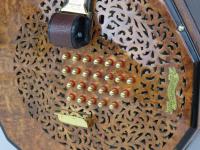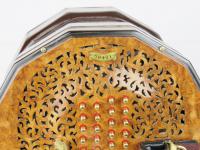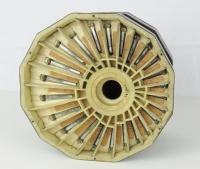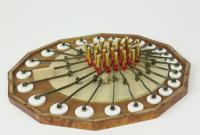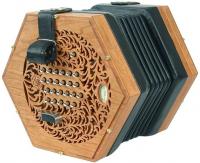
wim wakker
Members-
Posts
160 -
Joined
-
Last visited
Everything posted by wim wakker
-
Troubadour Wicky/Hayden duet
wim wakker replied to wim wakker's topic in General Concertina Discussion
Yes it is... The reason I did not use this format (which is more clear as far as keyboard layout is concerned), is because it doesn't explain the difference between the uni- and bi-directional keyboards, which makes much more sense in the 'up and down' picture. Explaining bellows performance is one of my (almost) daily routines... The bellows performance determines much of a concertinas overall playability, dynamics, and reed response. A mediocre instrument with high end (low resistance) bellows will often play much better than a high end instrument with (new) high resistance bellows. We replace quite a few brand new bellows on instruments send to us because they 'don't play well'. This is a basic explanation of different bellows qualities and how you can evaluate bellows: http://www.concertinaconnection.com/about bellows.htm -
Troubadour Wicky/Hayden duet
wim wakker replied to wim wakker's topic in General Concertina Discussion
I’ve changed the keyboard picture to ‘front view’. I didn’t realize that the ‘from behind’ view was so confusing for some. The Troubadour is a small duet, only 6 1/4” across the flats… reedpan surface is limited. It’s like building a 1000 sq ft. home with 12 bedrooms. We used 97% of the available space. From a technical point of view, the real achievement is that we were able to utilize so much of the reedpan and still were able to have a min. of 50% chamber over pressure reserve, an airflow pattern within a 25% variable, and a max. chamber/reed deviation of 8 cent. This means that the instrument performs really well; fast, even equilibrium (for accordion reeds), LH/RH harmonic consistency, great dynamic range and very limited harmonic distortion. Every small duet has limitations. Deciding which notes the instrument will have is a rational process: The goal is to provide access to the most used tonal and modal keys players at this level will use (worldwide, in all kinds of music). Limiting factors are price and size. The troubadour allows you to play in most major, minor keys, and modes. I would strongly advise any duet player to learn at least the basics of tonal harmony and voicing. There will always be ‘missing’ notes on a small duet, but that should not be a problem. There are always multiple alternatives for every harmonic function and chord. The limiting factor is more with the player than the instrument. During the development stage I designed several models, including a 34, 38, and 40 key. There are so many factors that go into deciding which model would work best: playability, quality, harmonic equilibrium, dynamic range, size, cost, weight, production complexity/time, etc. The number of buttons is only a small part of the decision. As a side note: We have several customers that own both our (Wakker) 46 and 65 key duets. Several of them have told us that they prefer playing the 46 key model because of size, weight, etc. The same is true for english players that have both a 56 key TT and 48 treble. If you want to play a small duet, and are willing to school yourself in harmony and voicing to learn how to deal with a limited compass, I think the Troubadour is a big step up from our Elise as far as sound, dynamics, equilibrium, speed, air economy etc. is concerned. We’re still fine tuning the production, which will take a few months. During this time the availability is limited. Right now, the instrument is only available directly from us. The dealers will get the Troubadours probably late Jan/Feb. -
Troubadour Wicky/Hayden duet
wim wakker replied to wim wakker's topic in General Concertina Discussion
The Troubadour has 36 keys + airbutton= 37. You can easily play in A major without the 3rd (G#) of the dominant in the left hand. If you want to play harmonies (chords) it is always a good idea to play them 'wide' on a free reed instrument because of harmonics. In this case (A major dominant chord: E G# B D), you could play LH: E, B/RH G#. or RH D,G# (E7). or: LH E, B, F#/RH D,G# (E9), etc. Alternatively, when playing melody in the RH and harm. in the LH: play LH E, B or E, B, D (E7) for the dominant function. The 3rd (G#) might or might not be part of the melody. Harmonically it doesn't matter because you do not need the leading note to establish the harmonic function if the dominant 7 is present. In fact, you really want to avoid 3rd intervals under C4. -
Troubadour Wicky/Hayden duet
wim wakker replied to wim wakker's topic in General Concertina Discussion
About the layout pictures.... As I mentioned above the keyboards, it is seen from the players view. This is a common way of showing a keyboard in an educational setting. The view is from 'behind' the keyboard, as when you hold the instrument. The keyboard is the same of course as the Elise. -
Later than planned, but we finally added the Troubadour duet to our intermediate model line up http://www.concertinaconnection.com/troubadour.htm The Troubadour is a 36 key Wicky/Hayden duet, 6 ¼” across the flats, comparable to the Minstrel (anglo) and Busker (English). It fills the gap between our Elise and Peacock models. All our duet concertina models (excl. the Elise, but including all the Wakker duets) are available with either a bi-directional or uni-directional keyboard. The final addition to our hybrid duet models will be the Peacock XL, a 50+ key version of the standard Peacock. We built several proto types varying from 54 to 58 keys, but have not decided yet which one will go in production. We expect this last hybrid duet model to be available mid/late 2020. Finally, because of the many requests, we decided to offer the Minstrel also with Jeffries layout. Wim Wakker Concertina Connection Inc. Wakker Concertinas
-
For sale is our backup (less than 100 hrs) Tunkers variable speed gluing machine, model ‘Liliput 150”. This is an industrial quality machine with a very small footprint (14” x 15” x 7 ½”, weight: 35 lbs). This model is for water based cold glues. It comes with a 2nd glue pan. It is used for applying glue to bellows papers, bindings, and hinges. Both glue film and application speed are variable. Current new price is around $2300 (E.1990) plus shipping from Germany. It’s available for $1200 excl. shipping. Factory brochure (PDF in English) is available. Wim Wakker Concertina Connection Inc. Wakker Concertinas
-
I agree. The main addition i would like is a mirrored left hand option, but that's proably not in the cards for keeping the price down. ron Actually, all our duet models (Peacock, future Troubadour, and the Wakker duets) are available with a mirrored left side. We don't charge extra for that. Mirrored duets make more sense to free bass accordion players who switch to duet concertina. Bayans also come with both variations for the left hand; the Russian system (bottom low/top high) and the western system (top low/bottom high). The CT referred to ‘Closed Tension’, which was explained earlier in the article I copied the text from. CT stands for Closed Tension, as opposed to OT Open Tension. Bellows tension is one of the subjects measured in a bellows evaluation and was explained earlier in the article (bellows tension (in grams), bellows travel (in percentage), stability (in pressure) and airtightness (airflow per minute)). “Bellows waist” is the difference in circumference between the bellows frames and the bellows. hope it makes more sense now... Wim, I tried to find your article on the web to answer my questions, but failed. Can you advise how I can access it. I did look before I asked my questions otherwise I would not have had the need to show my ignorance. Dave We don't have them on our site yet... I am still editing/organizing them...I have 4 of them finished, out of 10-15. The material comes from articles I wrote for free reed magazines (European), lectures and workshops.
-
Actually, I developed 2 models, one in a 6 1/4“ housing and one larger… We’re not sure which one will go in production. The smaller one is cheaper (Busker price), the larger one has more buttons but is therefore more expensive. Our primary objective for this model line is a low cost model, which is a big step up from the entry level models in playability, quality and sound. A larger instrument will probably be out of financial reach again for many players, especially for customers outside the US when you have to add 21% or more sales tax, import, shipping, etc.. We’re still working on it. Because this model line is modular in design, we only need about 4 weeks from final design to production.
-
The CT referred to ‘Closed Tension’, which was explained earlier in the article I copied the text from. CT stands for Closed Tension, as opposed to OT Open Tension. Bellows tension is one of the subjects measured in a bellows evaluation and was explained earlier in the article (bellows tension (in grams), bellows travel (in percentage), stability (in pressure) and airtightness (airflow per minute)). “Bellows waist” is the difference in circumference between the bellows frames and the bellows. hope it makes more sense now...
-
Hi Wim, could you please elaborate on what 'rig made bellows' are and how they differ from 'Wakker bellows'? Are we talking folded card vs. individual card construction? Hi Alex, I've enclosed an excerpt from “about Bellows”, a series of short technical articles on concertina construction I wrote. This explains the 3 basic (free reed) bellows designs, The full article also explains bellows evaluation etc.. Concertina bellows can be divided into 3 classes: Basic bellows Basic bellows are of the ‘accordion’ type. They consist of folded cardboard panels with leather or synthetic gussets, no inside hinges, linen fold covering and leather or synthetic bindings. Because the cardboard is folded, there is a certain amount of CT base tension in the bellows. Basic quality bellows are great for basic bellows control. You can control dynamics and they are air tight. Because of the construction and materials, they will get suppler with time, but will also lose some of their stability. Intermediate bellows Intermediate bellows are of the traditional concertina design. They consist of individual cardboard panels, often connected with leather top and bottom hinges, leather gussets, panel covers and leather bindings. The leather is often sheepskin, which has a lot of ‘stretch’. Glues used are often of the cement type, which have a strong hold but do not harden. These bellows are (almost) always made on a ‘rig’. This is a ‘maximum stretch’ or ‘50% stretch’ mold on which the panels are connected with the hinges and gussets. After the glue dries, the bellows are removed from the rig and placed in a press or under weights. Because the bellows are made in the open position, they tend to have a lot of CT, caused by tension in the hinges panel tip movement and gusset tension. Pressing the bellows in the closed position stretches the leather hinges and gussets. Rig made bellows usually require a case with blocks to keep the bellows in closed position. High end bellows High end bellows are also of the traditional concertina design. They consist of individual skived card panels, connected with leather top hinges and hard linen bottom hinges, leather gussets, silk tip reinforcement, leather or leatherette panel covers and leather bindings. The leather for the gussets and bindings is selected goatskin, which has no stretch, can be skived very thin without losing strength or becoming porous. Natural water based glues are used which harden fully with no shrinkage. Besides the materials, the big difference is the way they are constructed. No rig is used for high end bellows. Each set of bellows is measured individually to fit with a perfect ‘waist’ on the bellows frames. The waist determines the panel size. No two sets of bellows are identical in size. All panels are connected by hand, and before the glue sets, moved in the maximum open and fully closed position. This results in hinge connections without any tension. Panel tip spacing and gusset angle is determined by the maker and varies for each set of bellows. Varying factors are the number of sides (6,8,12), thickness of the leather, type of concertina (anglo bellows are different from English and duet bellows), and maximum bellows travel. Bellows constructed this way have very little travel tension. E.g. hexagonal bellows have a tension free travel of >90%, dodecagon bellows >96%. Standard values for concertina bellows is between 70-80%. Making high end bellows requires a lot of knowledge, skill and experience. It will take several hundred sets of bellows before you’ve developed any repeatable skills.
-
Regarding the Minstrel (anglo), Busker (English), and Troubadour (duet, available 2018) models…. A few facts: Except for our entry level models (Jackie/Jack/Rochelle/Elise), ALL our models (34 in total; 6 hybrids and 28 with traditional reeds, ranging in price from $445 to $34100), are made here in the USA. The only parts we import are the (accordion) reeds for the hybrid models (we make our own traditional reeds), and the bellows for the Minstrel/Busker/Troubadour models, which are made for us in the UK. We also import our tonewoods for the Wakker models ourselves from all over the world, because the quality and aging is not available in the US. We noticed that a growing number of (new) players were financially unable/not willing to make the jump from our entry level models to the next model up. We wanted to introduce a concertina line between our entry level (Rochelle, Jackie, etc) and intermediate hybrid models (Clover, Peacock, Rose) that would be - affordable (starting at $1030 with a trade in). - dependable: comes with our life time warranty and guaranteed trade in value when moving up. - comparable to other hybrid models in performance and materials: Materials: All wood construction (non-tonal), synthetic glues, acoustically invisible finish (ebonized), same (accordion) reeds as you’ll find in all the other hybrids, 6 fold traditional concertina bellows, delrin buttons (like most hybrid makers use), and a traditional rivet action. Performance: -bellows travel: resistance free travel with standard bellows:60-70% (same as all other rig made bellows), with Wakker bellows: > 90% -chamber/pitch deviation: <8 cent -chamber airflow dist.: free to G3, minimal below. -harmonics: balanced 5th-8th above D4. (= bright) - equilibrium, dynamic range, reed responds is comparable to other hybrids. - 6 ¼” across the flats, 2.4 lbs -Available options: metal capped flat or domed buttons (real concertina buttons), and Wakker bellows The lower price is possible because of design and production process changes. Especially with hybrid concertinas, most of the cost is in construction time, not materials or parts, which are only a fraction of the total cost. With dedicated machines and tooling developed especially for this model line, we were able to cut production time by almost 70%... same parts, reeds, etc., but at a much lower price. Wim Wakker Concertina Connection Inc. Wakker Concertinas
-
For sale is a rare Lachenal Edeophone baritone from ca. 1925, amboyna ends with gold plated keys/fittings. The instrument originally comes from my own collection, and was sold earlier this year to the current owner who recently passed away. I am assisting the family with the sale. Instrument history As a (former) professional classical concertinist, I have owned many concertinas over the last 30 years. Through the process of buying, restoring and selling, I selected the best instruments for myself, and would replace them when I found a better one. Over 500 instruments have gone through this process. I acquired this baritone in the late 90s, it replaced 2 Aeola baritones. It was my principle baritone for many chamber music concerts, radio and studio recordings, including TV documentaries in Europe. Condition The instrument is a maintained ‘old restoration’, meaning that the after the original restoration in the late 90s, it has been professionally service, tuned, and calibrated at least once a year, until 2008. Since then it has been kept in a temperature and humidity controlled environment with the rest of my vintage collection. Because it has not been played much lately, reed tension has diminished and will need to be build up again. In the current reed setup and voicing, I expect it to be at peak performance in ca. 50 hours playing. The amboyna veneers show some hairline cracks, which is normal for aged amboyna. The face plate foundation does not show any damage. The ends are solid and stable. There is the usual amboyna veneer replacement/discoloring. The ends are french polished, without ‘moisture guard’. The instrument has an original RIVETED action, mahogany soundboard, and sycamore reed pans. Bellows are in great condition. Technical data: - weight: 4.87 lbs - key travel/padlift: > 3.5/>8mm - key pressure: <80 gr. - compression: > 3500 gr (> 100%) - chamber airflow spread: 35% - reed response airflow: 30 fpm - Key tip weight: min. 4/max 7gr. - bellows: closed/open tension 800/600gr - bellows tension free travel: 66% Price: $5900 Disclaimer My role is limited to the technical aspect of the instrument. The Concertina Connection Inc. is not involved in the sale, this is a private sale. However, after the sale, we will take responsibility for the instrument which be covered by our (Concertina Connection Inc.) standard one year “Vintage restoration” warranty on parts and labor.
-
I’ve added 2 recordings on youtube from a concert I gave a while back in Germany. These recordings are interesting (I think) because the concert was played on period instruments; a Conrad Graf grand from 1838 and a Wheatstone English from 1877. The compositions are: -Rondo from the Sonata for Concertina and Piano Forte, by Berhard Molique. This is considered one of the most substantial compositions written for the concertina and is technically quite demanding. Bernhard Molique was a composer of high standing during the 19th century. He wrote several compositions for the concertina, of which his concerto for concertina and orchestra and this sonata were the most important ones. https://www.youtube.com/watch?v=kDQN7Pd8GhU -Barcarole for concertina and piano forte, by Sir George Macfarren. Musically less impressive than the Molique sonata, but a wonderful example of a 19th century character piece. https://www.youtube.com/watch?v=oVBB1X2kSVU I found some more radio/TV and concert recordings that I might add in the future, depending or rights, etc.. Wim Wakker
-
Reed Upgrades For The Rochelle, Jackie And Elise
wim wakker replied to wim wakker's topic in General Concertina Discussion
David: Glad you 're enjoying your instrument. We decided to postpone the introduction of the Rose baritone. As you might know, there are a few technical problems (equilibrium, reed coasting and dynamic differences) that come with installing lower accordion reeds in a concertina box that we want to solve first. Accordion reeds are designed for a large air reservoir and low airflow. A concertina basically is the opposite, which does create problems with lower reeds. The 1st generation Rochelles had Chinese reeds (different scaling), the current generation has Italian reeds. "Italian" doesn't always mean that the reeds were actually made in Italy....a lot of Italian reeds are produced somewhere else. All I want to say about these new reeds is that they are a step up, and are not Italian reeds. We prefer to keep their origin to ourselves, but let's just say that we have enough knowledge and experience in this field that we don't need to buy (Italian) stock reeds.... We ship the reed upgrades world wide. Shipping outside the US is $20. Wim -
Reed Upgrades For The Rochelle, Jackie And Elise
wim wakker replied to wim wakker's topic in General Concertina Discussion
First of all, there is no need to replace or upgrade your Elise (or Rochelle, Jackie/Jack which are all the same instrument). In the original form it will probably last 20+ years. The reason why you might want to upgrade certain parts is because there is some room for improvement. The best way to describe it is by comparing your instrument to a very basic car. You don’t need to change anything, it will run just fine the way it came from the factory, but you could change the upholstery to leather, maybe larger alloy wheels, different exhaust, modify or replace the engine, etc.. As you know updating/customizing a car is very common. Customizing/upgrading musical instruments may be less common, but also possible. I think you’ll be shocked to know how little difference there is between your Elise and other hybrid concertinas when you look at them from a technical point of view and compare the numbers (airflow value, air consumption, harmonic spectrum, etc.). All hybrid concertinas currently on the market (including some traditional ones) are reflection instruments only; all harmonic filtering/amplification is done by chamber and cavity reflection. They don’t use tone woods, acoustically invisible glues (variations of hide/bone glues) or finishes (e.g. French polish, alcohol based stains), which would allow the ‘box’ part of the instrument to interact with the sound waves. For instance, just the use of modern wood glues prevent sound waves to travel between wooden parts because it never really hardens and acts as a rubber insulator. The same goes for spray paints which (measurably) interfere with any acoustic properties of the wood. So, basically from a construction point of view, your Elise is on equal ground with the other hybrids. It might not look as nice, be larger, etc., but the performance is comparable. Mechanical parts like the action and buttons can be upgraded. The Elise has a wire riveted action (as most other hybrids do) and plastic buttons, comparable to Delrin. The ‘optimal’ action would be a (bushed) balanced sheet brass action (e.g. as used in the Clover, Peacock and Rose), with metal capped buttons. Personally, as a professional musician, I think plastic/delrin buttons are at the bottom of the ladder. The next step up would be bone, then all metal, and at the ‘top’ metal caped (domed or flat) nylon core light weight buttons. Because of the reflection only construction, I would keep the foil valves it has (much better harmonic spectrum from the reeds), but would upgrade the reeds. The advantage is the lower tip weight (also called Bernoulli weight), less airflow required for reed coasting and better dynamics. You can also adjust the airflow to the chambers by changing the air hole sizes. Finally, you could add ‘Wakker’ bellows, which have the largest percentage of resistance free travel (95%+). The lower bellows resistance will also improve the reed performance, both attack and dynamics. The reeds used in hybrid concertinas are basically the same.There are only a few manufacturers making them. They basically all produce identical harmonic spectra, with the typo al mano producing the most higher harmonics (harsh sounding) which makes them less ideal for concertinas. The difference is in airflow resistance/ reed economics, uniformity and sensitivity. -
Reed Upgrades For The Rochelle, Jackie And Elise
wim wakker replied to wim wakker's topic in General Concertina Discussion
No, the upgrade is sold separately. Besides the fact that we don’t have time to do the upgrades ourselves, the labor cost would make it too expensive. We have a limited number of sets available, and will decide if we’ll continue the upgrade after a few months. Our entry level models (Jackie/Jack, Rochelle and Elise) are perfect candidates for upgrading the reeds, action, buttons, finish, fretwork, bellows, etc… We’ll be willing to supply parts and instructions, but you’ll need to do the work yourself. For instance, the Rochelle can easily meet or even surpass the performance and sound characteristics of other much more expensive hybrids with a customized airflow pattern, sheet brass action, better reeds, etc.. Just like some people are able to upgrade/customize a basic car to a high performance one, the same can be done with a concertina. After 10 years there are now many thousands of these instruments all over the world. We frequently hear from owners what they have done to their instrument to improve/customize them to make them function better for their type of music. Personally I think that’s a good thing. The more concertinas become part of different cultures, the better it is for the concertina in general. We’re willing to supply the parts and develop upgrade kits for the action etc., but it is up to the player to do the work and get creative. Like I said, we’ll give it a chance. Wim -
Reed Upgrades For The Rochelle, Jackie And Elise
wim wakker replied to wim wakker's topic in General Concertina Discussion
it is a little harder, but not impossible. We use a small mirror and long nose pliers. -
Reed Upgrades For The Rochelle, Jackie And Elise
wim wakker replied to wim wakker's topic in General Concertina Discussion
Hi Don, I added a page with pics + instruction: http://www.concertinaconnection.com/reed%20exchange%20instructions.htm -
For years people have asked us for ‘better’ reeds for their standard accordion reeded concertinas. We finally decided give it a try, and offer high quality replacement reeds for the Rochelle, Jackie and Elise. They can of course also be used for your own concertina project…. The reeds come in complete sets, valved, reed wax, and instructions. The sets for the Jackie and Elise are slightly smaller than the original reed frames, and require some chamber reduction. We’ll include the material and instructions for this. The difficulty of this project: easy/moderate. Replacing the reeds will take about 2 hours. Tools you need are: screw driver, small knife, pencil, glue (e.g. elmers), and a lighter. If you’re building your own concertina and want something special…we have one (1) unique set available that you won’t find in any hybrid concertina. We will use these (slightly different frames) in the near future for our custom Clover model. more information: http://www.concertinaconnection.com/replacement%20reeds.htm Wim Wakker Concertina Connection Inc. Wakker Concertinas
-
Sounds Like A Concertina ?
wim wakker replied to Geoff Wooff's topic in Instrument Construction & Repair
Just a point of clarification, Wim. By the "fifth" in the quote above, do you mean the twelfth (i.e. the third partial, an octave and a fifth above the nominal)? Terry You're correct....for practical reasons it is usually referred to as the 'fifth' rather than the 'duodecime' (octave + fifth) -
Sounds Like A Concertina ?
wim wakker replied to Geoff Wooff's topic in Instrument Construction & Repair
Someone just forwarded a link to this thread to me…. A few facts: The reed amplitude and active reed length is determined by the relative difference in mass/resistance between reed base and tip. This difference can be obtained by either varying thickness of the reed or width. E.g., a wider reed base creates more resistance, just as a thicker base does. Another example: 2 reeds, one parallel and one tapered, of the same thickness and length: the tapered one will sound higher in pitch (reduced tip mass). Turn the tapered reed around (fishtail), and it will sound lower than the parallel one. The reed taper itself does not change/affect the reed movement. However, tapered reeds allow for much more manipulation of the harmonic spectrum because of increased reed amplitude. Depending on pitch and scaling, most reeds have less mass at the tip than at the base. Tapered reeds allow for a more consistent reed thickness, which allows for more manipulation. Because there is less difference in thickness between base and tip, the reed can be thinner, = more flexibility = more amplitude at same airflow = more harmonics/ manipulation. On a side note, modern vocal steel is more stable than 19th century steel. It is much easier to voice the fifth in a modern reed (tapered) than in an old one. Early instruments used baffles and fretwork to hide uneven harmonics and equilibrium: Lowest notes often were either too soft (early instruments), or too loud (Aeola/edeophone models). High notes often sounded harsh and did not follow the voicing line. Because modern reeds can be voiced perfectly, there is no need to hide any uneven harmonic spectrum. Modern free reeds produce stronger, more uniform harmonics and create a richer tone with a more even equilibrium over the full compass. In (our) modern concertinas we use chamber length, volume, and reed position, primary and secondary sound reflection in the action chamber to ‘shape’ the sound of our instruments. The reeds produce a constant spectrum which is either tempered or enhanced by (sound) filtering and reflection. The end result is determined by the customer: mellow sound/clear/bright. Etc.. in Geoff’s case, our standard duet concertinas have a ‘clear’ spectrum. We want all the notes to be audible, also when you play chords + a melody, not mushy and covered up by overpowering low notes. Sound preference is personal, and is also determined by playing skill/style. Someone who plays polyphonic music will require a much better balance than someone who plays single note melodies. The modern reeds do produce a much stronger octave and fifth than ‘old’ reeds, but this is by choice. It is very easy to make a modern reed sound (exactly) like a vintage one. You can even ‘copy’ the spectrum of a brass reed and make it indistinguishable in a brass instrument. Parallel chambers DO NOT necessarily affect sound quality. This is one of the myths that still exists. They make it easier to obtain a certain spectrum from the reeds, which can also be obtained with a radial reed pan. The bandwidth of radial (vintage) and parallel chambers overlap quite a lot. The position of vintage radial reed pans on this bandwidth can easily be covered with parallel chambers (can produce the same sound characteristics). Reed pan layout only becomes interesting at the extreme ends of the design, the small areas that you can only obtain with either radial or parallel. The size of the air holes (pad holes) is/should be determined by the amount of airflow needed in the chamber to start the reed swing cycle (bernouilli effect). The vent holes under the reeds act as the ‘chamber back door’, they determine the air pressure in the chamber. Accordion reeds have no vent holes. The frame slot determines the air flow rate. Because of this accordion reeds have different specs and harmonics than a concertina. a few remarks: Our (Wakker traditional) reeds are made by hand (by me personally). The reed frames are made on a specially designed (by me) CNC machine. Our frames are 3 dimensional, with a varying vent (varies in angle and height) per concertina model/pitch, to adjust the ‘reed pressure release’ (moment and rate the air pressure on the reed drops off). This can only be produced on a high end CNC machine, not by hand. We are the only ones that produce frames like this. All other concertina frames are 2D, with either straight slot walls or generically tapered. Wim Wakker -
Introducing the Rose english concertina
wim wakker replied to wim wakker's topic in General Concertina Discussion
No tenor -
Introducing the Rose english concertina
wim wakker replied to wim wakker's topic in General Concertina Discussion
The standard Rose is 2 lbs 12 oz. The special and custom are slightly lighter. We will offer a baritone Rose in the near future. Wim -
As promised, just before the end of the year, we are introducing the last of our intermediate models, the Rose english (http://www.concertinaconnection.com/rose.htm) The Rose is a 45 key (G3-A6) hybrid (with accordion reeds) treble english, positioned between our Jackie/Jack entry level models and the traditional reeded Wakker english concertinas. As with all our intermediate models, the Rose also has the same action as we use in our Wakker models: balanced sheet brass (MS58) levers with bushed metal capped nylon core buttons, key pressure set at +- 70 grams with a 3mm key travel. This type of action is a lot more responsive and uniform than one with wire levers and plastic buttons. The instrument utilizes a natural low pass harmonic filtering, which produces a less ‘accordion like’ sound, just like the clover and Peacock. . The consistent amplyfonic position of the reeds provide a very uniform equilibrium. Just like the Clover and Peacock, the Rose is also available in Standard, Special and Custom. Options include flat or domed metal capped buttons and natural or black finish. The Rose is also part of our trade-in program. Wim Wakker Concertina Connection Inc. Wakker Concertinas
-
Intel on "Hybrid: Reeds
wim wakker replied to ceemonster's topic in Instrument Construction & Repair
Both Theo and Malcolmbebb were correct. Accordion reeds used in concertinas are IDENTICAL to the ones used in accordions. No manufacturer is going to develop new reeds for such a small market. In fact, only a few manufacturers are willing to cater to the concertina makers. Salpa (antonelli) is by far the most popular at the moment. The only ‘customized’ accordion reeds for concertinas were developed by Harry Geuns in the late 90’s for the Geuns-Wakker hybrids. When these instruments were discontinued, Harry sold the design to Salpa. Last I heard was that they were used in a new jazz accordion model. There is a choice between the different standard accordion reed qualities, ranging from export to ‘a Mano’ (Note: ‘hand made’ accordion reeds actually are hand finished and assembled, not made by hand from scratch). The major difference between the reed qualities is in responsiveness, air economy and consistency of the harmonic spectrum At low FPM values (foot per minute). As Theo explained, air flow velocity in an accordion is much lower than in a concertina. Therefore the reed FPM value is relevant in accordions: the higher quality reeds (TAM, AM) perform better at these low values (<200FPM). Concertinas produce much more air flow, which makes the reed quality difference much less relevant. Even at low velocity, a concertina will produce almost twice the amount necessary for the average accordion reed. To put it in perspective, if you need to drive 30 mph in a car, it doesn’t make any difference if you have an 8 or a 12 cylinder engine. Both engines can easily reach that speed….. Wim Wakker Concertina Connection Inc. Wakker Concertinas


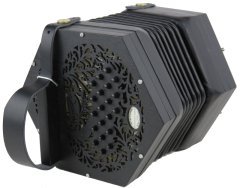
.jpg.713b361b548a7cbd19dd7ab375494933.jpg)
.jpg.5cff83468cdb03947e67c3966a62889d.jpg)
.jpg.781de744778a3c9072f71dee40a9cc4c.jpg)
.jpg.92121371961fb44b0f04e07a84d221f7.jpg)
.jpg.646ca5dfb247b3c90882d0c97d402728.jpg)

